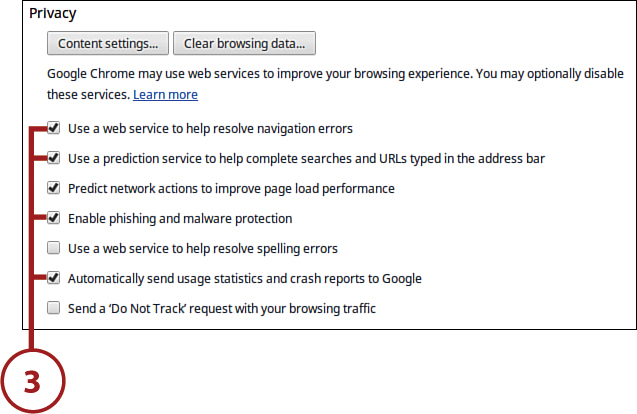15. Optimizing Your Chromebook’s Performance
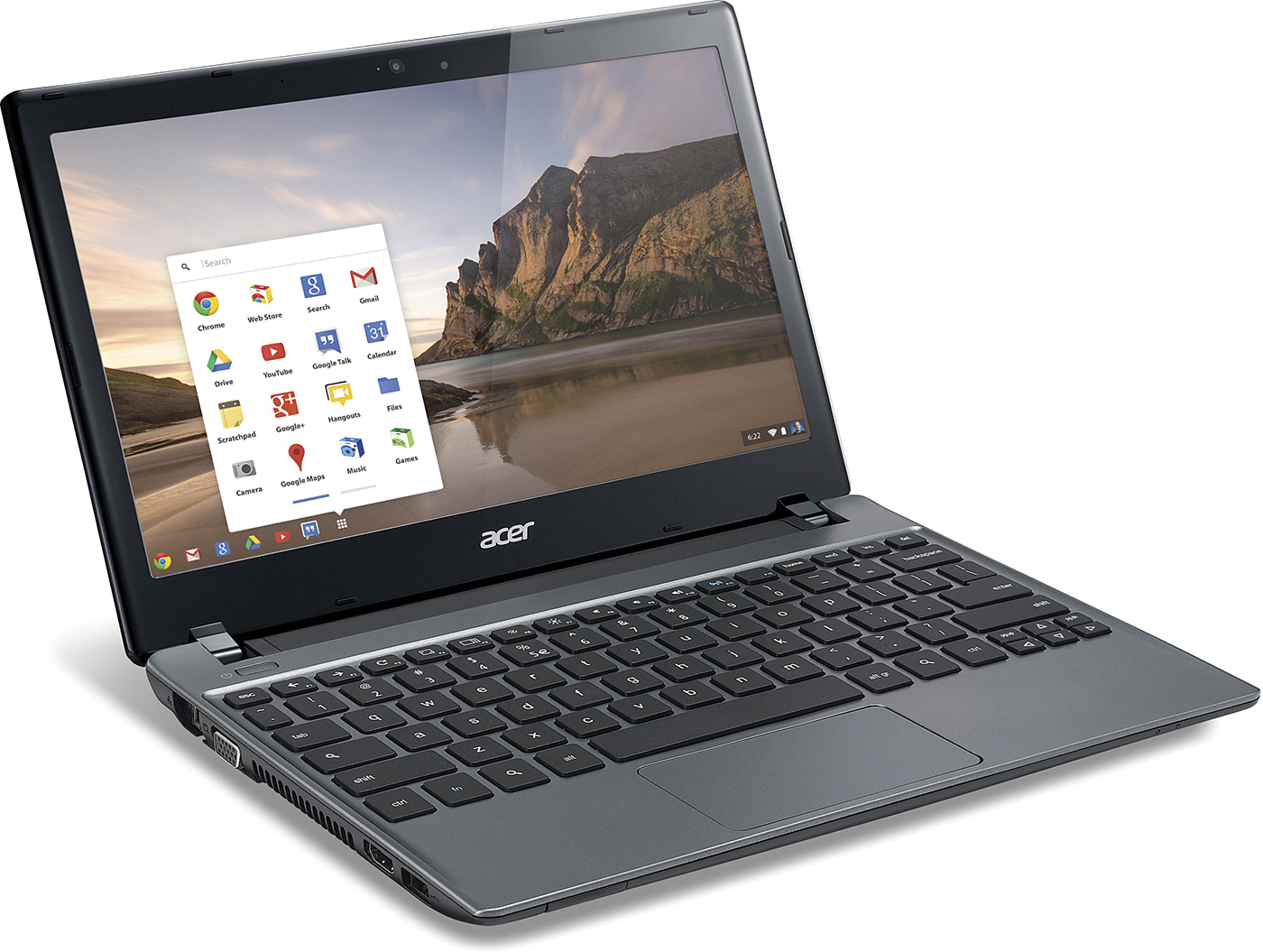
In this chapter, you find out how to get the most from your Chromebook.
Out of the box, a Chromebook is a very fast computer with a long battery life. There are things you can do, however, to make it run even faster—and last longer on a charge.
Optimizing Battery Life
Let’s start with your Chromebook’s battery life. On average, you’re going to get 4 to 6 hours per charge, depending on the model, which is pretty good. Your battery might last longer, however, if you take the appropriate precautions.
Use the Right Adapter
Use only the charger/adapter supplied by your Chromebook’s manufacturer, or an authorized replacement. Using the wrong charger/adapter can negatively affect the life of your battery—or even damage the Chromebook itself.
Keep It Cool
Batteries don’t like heat. The hotter the room, the less the battery will hold its charge—and the increased likelihood you’ll damage the Chromebook. Worst-case scenario, your Chromebook will get hot enough to catch fire. This is not desirable.
It’s best, then, to keep your Chromebook as near room temperature as possible, even when it’s not in use.
Keep a Little Charge
When you’re not using your Chromebook for an extended period, charge the battery to about the 30% or 40% level. This level of charge maintains battery performance as best possible.
Dim the Screen
When running on battery power, turn down your Chromebook’s screen brightness. A brighter screen draws more power, and runs the battery down faster.
Disable Wireless
If you’re not working online, turn off either or both Wi-Fi and 3G wireless functionality. (Not all Chromebooks offer 3G, of course.) Your Chromebook’s wireless receiver draws a lot of power.
Of course, your Chromebook is fairly useless if not connected to the Internet, so this might not be a viable option. If you have an Ethernet connection, however, you can use that and turn off the wireless function.
Disk Use
On a traditional notebook computer, you are advised to minimize the use of your hard disk and optical disk (DVD) to maximize battery life. Because your Chromebook doesn’t have a DVD drive (and most don’t have hard drives), this advice doesn’t translate.
Speeding Up Performance
On a traditional computer, you can speed up performance by managing how programs use the PC’s memory and hard disk. Because most Chromebooks don’t have hard disks, there isn’t much to manage there—which is one of the reasons a Chromebook is so fast by default.
There are a few things you can do, however, to speed up the performance of your Chromebook. Because most of what you do will be web-based, most of these tricks involve how you browse online.
Don’t Multitask
Each web app that’s running takes up processor capacity, memory, and upload/download bandwidth. If you have multiple apps running simultaneously, in multiple browser tabs or windows, that can really slow down your Chromebook’s processing—and clog up your Internet connection.
This can even be the case if some of those apps are running in the background, like a real-time weather or stock app. Bottom line, if you don’t want your Chromebook to become too sluggish, close some of those browser tabs.
Disable or Remove Extensions
Similarly, the Chrome extensions you install can create a drain on your memory and processing power. The more little buttons you have on the Chrome toolbar, the more things your Chromebook has to run. Speed things up by disabling or removing those extensions you don’t really need or use, as discussed in Chapter 11, “Using Chrome Apps and Extensions.”
Enable DNS Prefetching
When configured properly, the Chrome browser can “prefetch” all the URLs on each web page you load, essentially looking them up in advance in the event you click them. This speeds up the loading of any subsequent pages you click to, which results in faster browsing.
1. From within the Chrome browser, click the Customize and Control button to display the drop-down menu.
2. Click Settings.
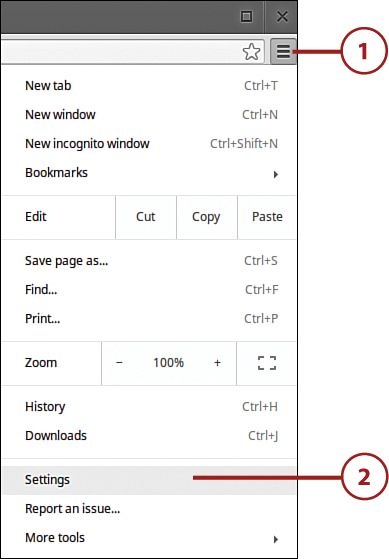
3. When the Settings page appears, click Show Advanced Settings and then go to the Privacy section and check the Predict Network Actions to Improve Page Load Performance option.
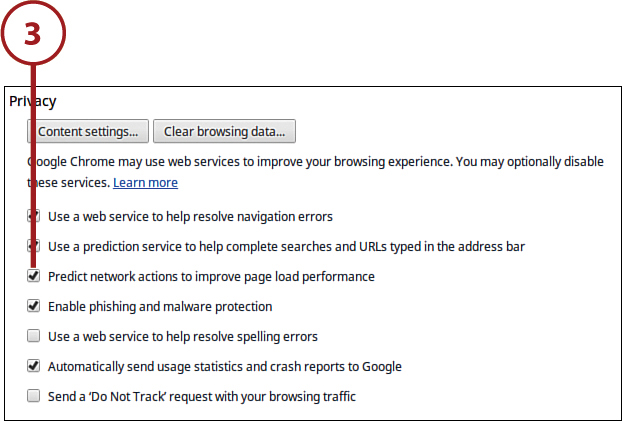
Disable Feedback to Google
There are several configuration settings that send information to Google for further action. Forgetting for the moment the privacy implications of these operations, they can slow down your web browsing—especially if you’re on a slow connection. Data you send upstream to Google can clog up the pipeline for the data you need to flow downstream.
1. From within the Chrome browser, click the Customize and Control button to display the drop-down menu.
2. Click Settings.
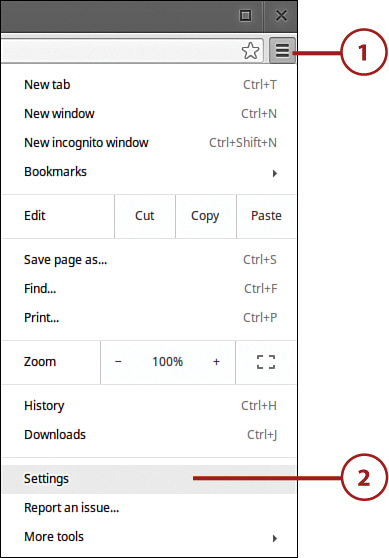
3. When the Settings page appears, click Show Advanced Settings, and then go to the Privacy section and uncheck the following options:
• Use a web service to help resolve navigation errors
• Use a prediction service to help complete searches and URLs typed into the address bar
• Automatically send usage statistics and crash reports to Google
